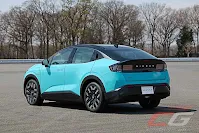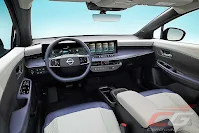The third-generation Nissan Leaf has now made its debut after revealing some key specs earlier as part of its lead up. A key part of the company’s Re:Nissan turnaround plan, the all-electric pioneer comes with a sleeker design, significantly extended range, and higher levels of technology.
Designed at Nissan’s Global Design Studio in Atsugi, Japan, the all-new Leaf is both dynamic and aero efficient. With a drag co-efficient of just 0.25, it’s optimized for performance and range. Tricks include flush door handles, flowing roofline, full under floor cover, and sculpted surfaces. The signature lighting, with an available lightbar that spans the length of the hood, is positioned above the illuminated Nissan logo, while at the back are 3D holographic taillights with a “digital Zen” look to it.
Powering the Leaf are two liquid-cooled lithium-ion battery options: 52 kWh and 75 kWh. The smaller battery offers up to 434 kilometers of range, while the larger one tops out at 603 kilometers. Tractive effort is provided by a new 3-in-1 EV powertrain that’s lighter and smoother than ever. It provides either 217 horsepower (160 kW) and 355 Nm or 176 horsepower (130 kW) and 345 Nm. It both features Nissan’s unique motor control for enhanced refinement.
With a DC fast-charging capability of up to 150kW, the Leaf can recover up to 418 kilometers of more range in just 30 minutes. With that, Nissan says an 804-kilometer road trip can be completed with minimal time difference to combustion engine vehicles. It also ditches the CHAdeMO charging standard for the more widely-accepted CCS2 (NACS in North America).
Like the Ariya, the Leaf now rides on the modular CMF-EV platform with front independent MacPherson Struts and rear Multi-Links. All in all, Nissan says it has 66 percent better lateral stiffness compared to the current model, an improved turning radius of just 5.3 meters, and a 2 decibel drop at 50 km/h compared to now. Wheel sizes are either 18 or 19 inches. The 18s come in two widths, 195 or 215, while the 19s come with the thickest option with 235/45R19s.
The use of the platform also means that despite its compact exterior size, it has a roomy interior thanks to clever packaging such as moving the HVAC unit under the hood rather than behind the instrument panel and a fully flat floor. It also has a 437-liter cargo space with a power tailgate.
Key features include a new monolith-style display with either dual 12.3- or dual 14.3-inch screens, a Bose Personal Plus premium audio system with speakers integrated into the front headrests, and a Nissan-first Dimming Panoramic Roof. The embedded Polymer Dispersed Liquid Crystal (PDLC) allows owners to enjoy natural light at the touch of a button, while coated with an infrared reflective coating heat shielding that reduces sun load.
The Leaf also boasts of more advanced driving aids including ProPilot Assist with Navi-Link, intelligent brake regen (including the one-pedal e-Pedal setup), a 3D 8-point Around View Monitor with invisible hood and front wide view, and more.
The Leaf also comes with V2L (Vehicle-to-Load) and V2G (Vehicle-to-Grid) functionality. V2L enables it to power small to medium-sized devices up to 3.6 kW using an external V2L charging port. Meanwhile, V2G means it can send stored energy back to the power grid reducing energy costs for its users.
The all-new Nissan Leaf will be assembled at Nissan’s Tochigi Plant in Japan as well as in its Sunderland, United Kingdom plant. Deliveries start by early next year.


















what is the price again? so much competition now.
ReplyDeleteLooks like a Tesla clone
ReplyDeleteTo reduce the price, they should create a variant without a sunroof, without V2L and V2G, and a generic audio system.
ReplyDeletelooks like an ariya
ReplyDelete